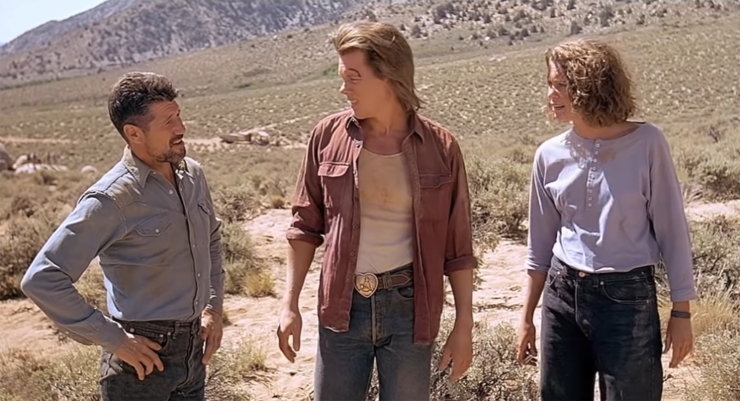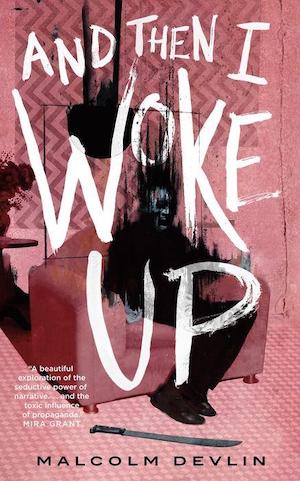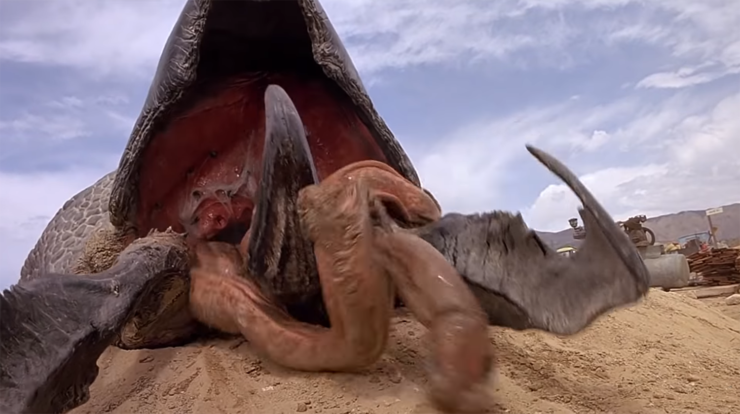When it comes to creature features—the horror subgenre built around monstrous beasts and the spectacular havoc they tend to wreak—two decades stand out. The atomic anxiety of the 1950s gave birth to classics such as Godzilla, as well as generating future Mystery Science Theater 3000 fare like The Crawling Eye. Then, as the conservative revival of the 1980s took hold in the U.S., filmmakers critiqued the movement and resulting cultural shifts via darker, more cynical features such as David Cronenberg’s The Fly and John Carpenter’s The Thing.
Although praised less rarely, the 1990s also saw its fair share of films that share significant DNA with classic creature features, from Steven Spielberg’s blockbuster Jurassic Park to the Renny Harlin schlock favorite Deep Blue Sea. Unlike their predecessors, however, these movies were often upbeat and fun, escapist films that celebrated the strangeness of the monster instead of the vileness of humanity. In these movies, man is rarely the true monster.
No movie signaled this change in approach better than Tremors. With its impressive practical monster effects and cast of small-town oddballs, Tremors changed the direction of creature features to something wackier and more fun, but no less interesting.
Directed by Ron Underwood and produced by genre great Gale Ann Hurd (The Terminator, Aliens), Tremors stars Kevin Bacon as Valentine McKee and Fred Ward as Earl Bassett, two down-on-their-luck handymen living in the desert village of Perfection, Nevada. Val and Earl are ready to finally move on to the big city of Bixby, when an onslaught of giant sandworms—dubbed “graboids” for their tendency to lasso victims with their tentacles—block their way. Together with a group of local weirdos and a seismologist from a nearby university (Finn Carter), Val and Earl have to defend the home they’d rather leave.
The Imperfect People of Perfection

The appeal of Tremors might stem from its monsters, but the movie’s heart is its cast, beginning with leads Bacon and Ward. The duo has an easy, pleasing chemistry, with Val as the angry young idealist and Earl as his grouchy older mentor. Screenwriters S.S. Wilson and Brent Maddock give Earl and Val simple, relatable motivations: both men are tired of doing manual labor in the desert, and it takes Val’s restlessness to inspire Earl to overcome his resignation and follow his dreams. Likewise, Earl’s wisdom allows him to call out Val’s unrealistic exceptions—specially, his shallow expectations for a supermodel girlfriend—and to see the true value of people around him.
But beyond functioning as just a buddy comedy, Tremors offers an entire ensemble of colorful locals played by great character actors. Frequent John Carpenter collaborator Victor Wong is shopkeeper Walter Chang, David Lynch mainstay Charlotte Stewart is worried single mother Nancy (with future Jurassic Park Linux expert Ariana Richards playing her young daughter, Mindy), and, in the most surprising turns, sitcom star Michael Gross and country music legend Reba McEntire play gun-toting survivalists Burt and Heather Gummer.
Buy the Book


And Then I Woke Up
Although she plays one of the movie’s less outrageous characters, Finn Carter is fantastic and essential as seismologist Rhonda LeBeck. Carter plays up the comic nature of her character, introduced to us as she stumbles through the dust and bounds toward the camera, her nose slathered in sunblock. LeBeck serves as the necessary leader when she joins up with Val and Earl, building on their comic rapport while giving the bumbling do-gooders the tools to succeed.
This strong communal aspect is central to the movie’s narrative and thematic stakes. In terms of the narrative, it’s the love of the community that keeps Val and Earl in Perfection, even when they are ready to leave: When they pass by a local known for his drinking stuck on an electric pole, the men decide to pause their trip and tend to him, leading to their first indication of unusual problems in Perfection. From then on, they refuse to leave the town because doing so would harm their friends, thereby propelling the heroes back into the action.
On a thematic level, this group of weirdos creates a community that we viewers both care about and laugh at. We might chuckle with glee when the Perfection folks flail around, trying to stop Walter’s malfunctioning soda machine from attracting a graboid, but we also genuinely cheer when they trick a worm into smashing its head into a basement wall. Even I, who have made my reservations about guns known here on this very website, laugh with delight when the Gummers realize that a graboid has slithered right into their armory.
Graboids Grab the Imagination
Creature features live and die by their monsters, and Tremors’s graboids are incredibly effective. Although David Lynch’s Dune (1984) and Tim Burton’s Beetlejuice (1988) had already given the world different versions of giant sandworms, the graboids are somehow more bizarre and more disgusting. Earthy brown slugs with grasping tendrils protruding from their multi-beaked mouths, graboids are made all the more disturbing by their resemblance to everyday creatures. We believe that the monsters smell hideous, as well, not just because of the revulsion on the faces of Earl and Val, but because of their unnatural writhing and the red goop bubbling up from the ground.
Following the lead of Ridley Scott in Alien and Spielberg in Jaws, Underwood keeps the graboids hidden at first, letting us see their effects long before we see their bodies: the rumbling of the ground, a jackhammer pulled away after puncturing a hidden beast, a single tentacle exploding from the dirt. The film forces viewers to imagine the monsters, and then only reveals them in full through quick and partly obscured glimpses. For most of the movie, we’re forced to grapple with something that we can’t really see and can’t really understand, something that sort of looks like a grotesque version of an ordinary earthworm…something that defies full comprehension. And that is terrifying.
More importantly, this delayed revelation allows viewers to learn about the graboids along with the characters. We know before the characters that monsters exist because we know we’re watching a horror movie, but we don’t know much more than that. We too only see the graboids in quick glimpses and, as a result, we appreciate the knowledge Rhonda brings to the action, as she’s the first person who can finally tell us what’s going on. More importantly, we get pulled into the action right along with the caricatures. When a tentacle escapes from the ground and shrieks at old farmer Fred (Michael Dan Wagner), his confusion is our confusion. When the first graboid finally reveals its twisted beak, we share in Val’s shock and disgust.
Us vs. It = Fun
It’s this portrayal of a community that distinguishes creature features of the ’80s from those of the ’90s. Where The Thing was about paranoia and The Fly about a secretive outsider, movies like Jurassic Park, Anaconda, Lake Placid, and others were about groups of oddballs working together to survive the beasts that are hunting them. And while this “let’s band together!” approach may not be as darkly thought-provoking or as intellectually stimulating as the older explorations of humanity’s dark side, Tremors stands as a delightful reminder that monster movies don’t need to be deep to be a whole lot of fun.
Originally published January 2020
Joe George‘s writing has appeared at Think Christian, FilmInquiry, and is collected at joewriteswords.com. He hosts the web series Renewed Mind Movie Talk and tweets nonsense from @jageorgeii.










